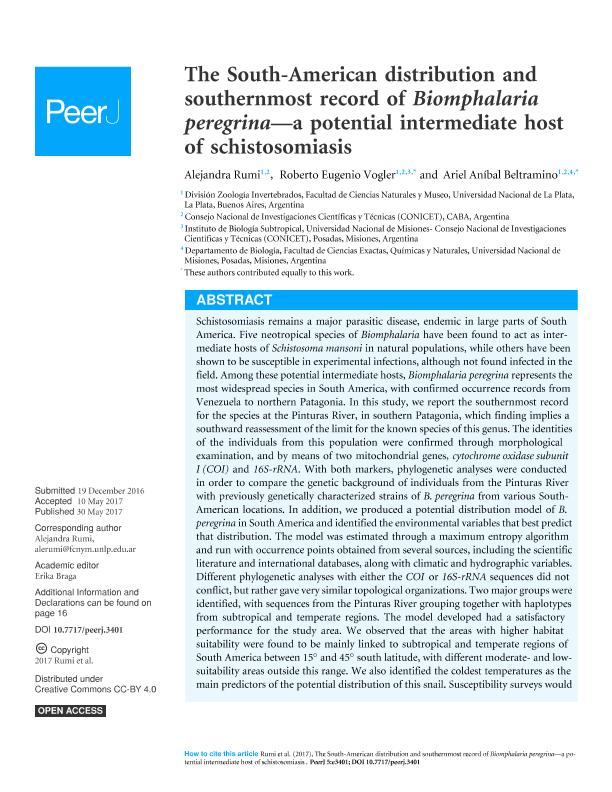Artículo
The South-American distribution, southernmost record, and genetic variability of Biomphalaria peregrina - a potential intermediate host of schistosomiasis
Fecha de publicación:
05/2017
Editorial:
PeerJ Inc
Revista:
PeerJ
ISSN:
2167-8359
e-ISSN:
2167-8359
Idioma:
Inglés
Tipo de recurso:
Artículo publicado
Clasificación temática:
Resumen
Schistosomiasis remains a major parasitic disease, endemic in large parts of South America. Five neotropical species of Biomphalaria have been found to act as intermediate hosts of Schistosoma mansoni in natural populations, while others have been shown to be susceptible in experimental infections, although not found in the field. Among these potential intermediate hosts, Biomphalaria peregrina represents the most widespread species in South America, with confirmed occurrence records from Venezuela to northern Patagonia. In this study, we report the southernmost record for the species at the Pinturas River, in southern Patagonia, which finding implies a southward displacement of the limit for the known species of this genus. The identities of the individuals from this population were confirmed through morphological examination, and by means of two mitochondrial genes, cytochrome oxidase subunit I (COI) and 16S-rRNA. With both markers, phylogenetic analyses were conducted to assess the pattern of genetic variation of B. peregrina, and to explore evolutionary relationships of these southernmost individuals from the Pinturas River through available DNA sequences for the species from various locations. In addition, we produced a potential distribution model of B. peregrina in South America and identified the environmental variables that best predict that distribution. The model was estimated through a maximum entropy algorithm and run with occurrence points obtained from several sources, including the scientific literature and international databases, along with climatic and hydrographic variables. Different phylogenetic analyses with either the COI or 16S-rRNA sequences did not conflict, but rather gave very similar topological organizations. Two major groups were identified, with sequences from the Pinturas River grouping together with haplotypes from subtropical and temperate regions. The model developed had a satisfactory performance for the study area. We observed that the areas with higher habitat suitability were found to be mainly linked to subtropical and temperate regions of South America between 15° and 45° south latitude, with different moderate- and low-suitability areas outside this range. We also identified the coldest temperatures as the main predictors of the potential distribution of this snail, which thermal driver could act as a climatic barrier for the spread of schistosomiasis into temperate regions. Nonetheless, susceptibility surveys would be required to evaluate if southern populations of B. peregrina still retain their potential as intermediate hosts of S. mansoni.
Palabras clave:
Gastropoda
,
Planorbidae
,
Potential Distribution
,
South America
Archivos asociados
Licencia
Identificadores
Colecciones
Articulos(IBS)
Articulos de INSTITUTO DE BIOLOGIA SUBTROPICAL
Articulos de INSTITUTO DE BIOLOGIA SUBTROPICAL
Citación
Rumi Macchi Z., Alejandra; Vogler, Roberto Eugenio; Beltramino, Ariel Anibal; The South-American distribution, southernmost record, and genetic variability of Biomphalaria peregrina - a potential intermediate host of schistosomiasis; PeerJ Inc; PeerJ; 5; 3401; 5-2017; 1-26
Compartir
Altmétricas




